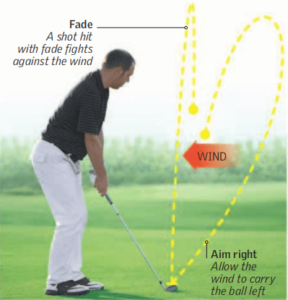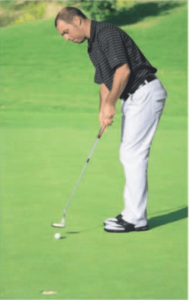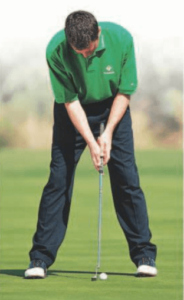A round of golf in the wind presents a greater challenge than playing on a calm day, but breezy conditions need not blow you off course.
Assessing the conditions—knowing which way the wind is blowing— is something you will need to recheck as you work your way around the turns and contours of the course.
But hitting the right shots for the conditions is ultimately what counts. Here are a handful of ideas that will help you hit your driver and irons low into the wind:
Table of Contents
Swing smoothly off the tee
Move your feet 5 in (13cm) farther apart than normal for a solid strike. Do not tee the ball too low, since this often causes you to swing down more steeply. However, you should tee the ball a fraction lower than normal for a slightly lower flight (but focus on sweeping the ball away).
Solid foundations
When playing in a strong wind, you may be blown off balance. Widening your stance gives you a more stable foundation.

Keep the ball low
There is no joy in playing a high ball into a strong wind. You will struggle to judge distance, the ball is easily blown off line, and you will have little control over the outcome of your shot. Therefore, keep the ball low and opt for a less-lofted club than you would otherwise use. If, for example, you are 150yd (135m) from the flag and that represents a normal 7-iron shot, club up to a 5-iron.
Compensating for wind
When playing a shot into the wind, club up to produce a lower ball-flight, and remember the old adage: “swing with ease into the breeze.”
Shape your shot or adjust your aim
In a crosswind you have two options. If you are proficient at shaping the ball with sidespin, work the ball into the wind. Or else, play a straight shot in which you aim left or right of the target.
Crosswinds
In the right-to-left wind, you can either play a fade, so that the ball holds its line, or aim right and let the wind blow the ball toward the target.

Wind influences break and speed
Few golfers take into account the fact that a strong wind affects the ball’s journey as it moves along the green. A crosswind either exaggerates or cancels out the break on a putt; a tail wind makes a putt run faster; and a headwind slows the ball down.
You have to allow for these factors when you read each putt, even from short range. This becomes a bit of a balancing act, but, if you are aware of the wind’s speed and direction, you can take steps to compensate for its effects.
Wind Break
A strong wind makes a difference to the break and speed of a putt, especially on fast, well-manicured putting surfaces. So do consider the wind’s influence while putting.

Widen your putting stance
The act of putting involves such a precise movement that even the slightest buffeting from the wind can upset the path and pace of your stroke.
Widen your stance by up to 50 percent more than normal. Choke down on the grip so that you are more crouched over the ball. This lowers your center of gravity. Hit a few putts.
Helpful article: How wide should your golf stance be
Remain steady
If you widen your stance and choke down on the grip, you will find it easier to hold constant body and head positions.

Punching the ball low
The “knockdown-punch shot,” as it is often called, is suited to a variety of situations. This type of stroke is a great weapon to have at your disposal when playing into a strong headwind, helping the ball hold its line. It is also useful when you want to pitch a ball short of the green and let it run up to the flag.
Reduce the loft on the club
The ball needs to go back in your stance by as much as three ball-widths, which delofts the clubface by several degrees.
Also push your hands even farther forward than normal so that the shaft is angled toward the target. In doing so, you have to be careful that the clubface does not become open. Turn in the toe of the clubhead slightly to ensure that the face is looking at the target. Your weight at address should be evenly spread.
- Follow-through: Keep your follow-through low to reflect your desire to produce a low ball flight
- Torso: You should sense that your torso is over the ball as you sweep the ball away through the hitting zone
Drive the ball and finish low
Try to sweep the club away low to the ground and make a shorter, more compact backswing than normal. Do not forget to turn your shoulders, though. Then, in your downswing, keep your torso over the ball at impact, and swing the clubhead low to the ground through the hitting zone.
Again, your follow-through should reflflect the ball flight, so make sure your hands stay low in the finish.

Related post: How to play golf in the wind



